The Sumatra breed of chickens is native to the small island of Sumatra in Indonesia. The Sumatra chicken has a beautiful exterior appearance. The chicken has long exotic flowing curves, a unique green luster, and excellent feathering.
Unlike many chicken breeds that have been crossbred, the Sumatra developed by living in the wild and adapting to its environment.
| Feature | Sumatra Chicken Characteristics |
|---|---|
| Purpose | Ornamental (neither meat nor egg-focused) |
| Egg Color | White or lightly tinted |
| Egg Size | Small |
| Broody | Yes |
| Heat Tolerance | Yes |
| Cold Tolerance | Yes |
| Comb Type | Small pea comb |
| Egg Production | Approximately 100 eggs/year |
| Chicken Skin Color | Greenish black |
| Life Span | 7-9 years |
| Adult Weight (Rooster) | 4.96 – 5.95 lbs (2.25 – 2.70 kg) |
| Adult Weight (Hen) | Approximately 3.96 lbs (1.8 kg) |
| Backyard Friendly | 3/5 |
Background and History of Sumatra Chickens

The Sumatra chicken is a rare breed. Sumatra has the personality of a wild game chicken. This breed is said to be what the original chicken looked and acted like before domestication.
Some of the first Sumatra chickens were imported to the United States around the 1800’s. Cockfighting was one of the original purposes for breeding and importing Sumatra chickens to other locations.
On the island of Sumatra, the residents would capture the Sumatra male chicken at the beginning of the breeding season. During the breeding season, the males are stronger and more aggressive. The residents of the island would use the male Sumatra chickens to fight as entertainment.
Once the breeding season was over, the male Sumatra chickens would be released back into the wild. The breed has evolved slightly over time, but the seasonal aspect remains the same.
A unique characteristic of the Sumatra chicken is that they tend to reproduce on a seasonal schedule. The Sumatra male chicken can be very domineering. They are territorial and fight for breeding rights.
This usually occurs a few months out of the year. Experts suggest the breeding season lasts all of spring. It is said that when the breeding season is over, Sumatra male chickens get along great and are able to live in close proximity.
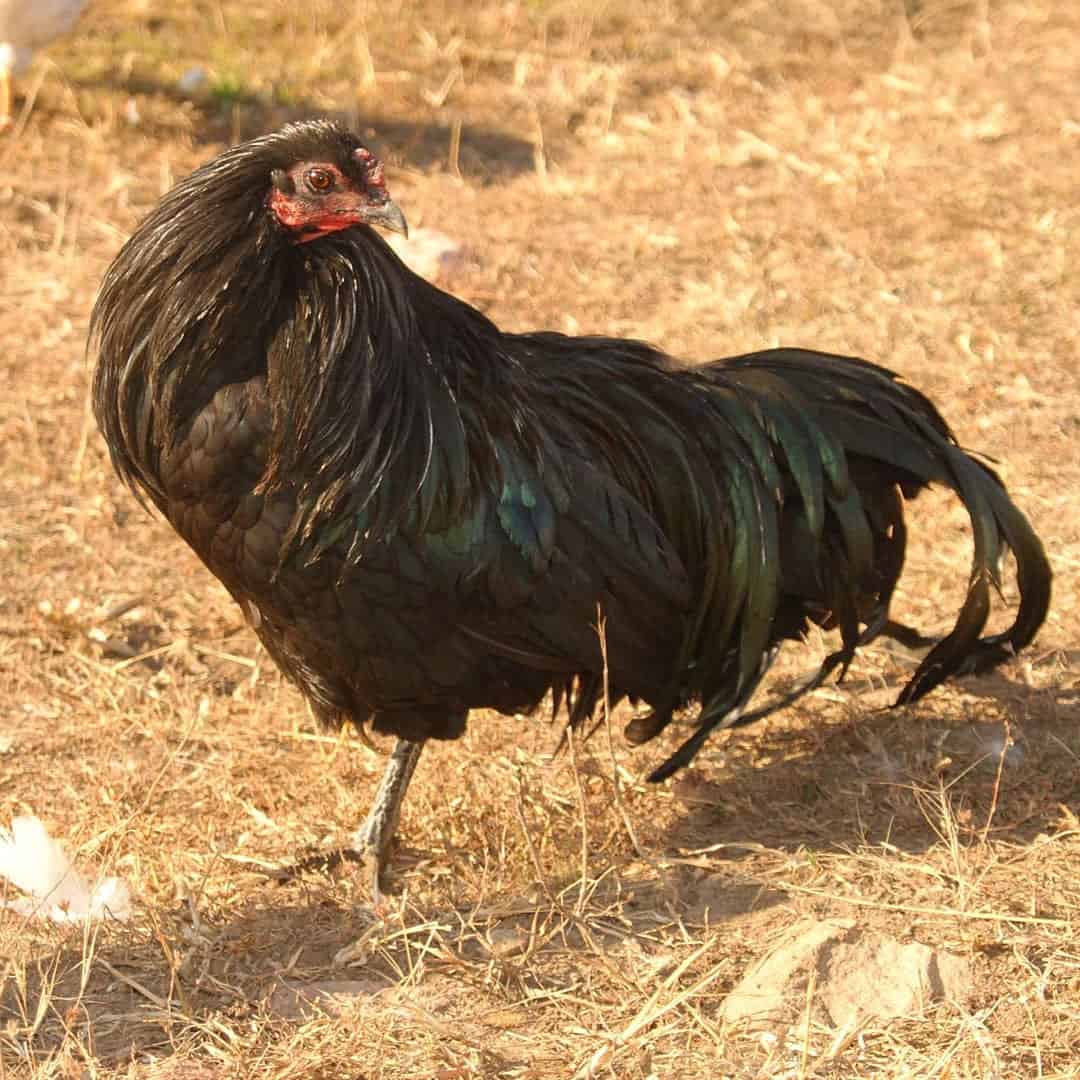
The Sumatra chicken breed resembles the behavior of a pheasant. They are great ground foragers. The Sumatra chicken moves in a distinct stately manner. They prefer to have free range and explore bushes and other large areas.
Although unclear, some say the Sumatra chicken used to have great flight capabilities. It has been noted that the breed used to fly between islands in the Indonesia region, particularly the islands of Java and Sumatra.
Initially known as a wild bird, things slowly changed for the Sumatra breed. Although the male Sumatra was aggressive during the spring months, it’s a misconception that people primarily viewed them as a “fighting game.”
They can have bouts of aggressive behavior, but overall Sumatra is a calm species. Residents began to learn this fact and started to crossbreed the Sumatra male with other fighting breeds.
Sumatra Chicken Breed Standard
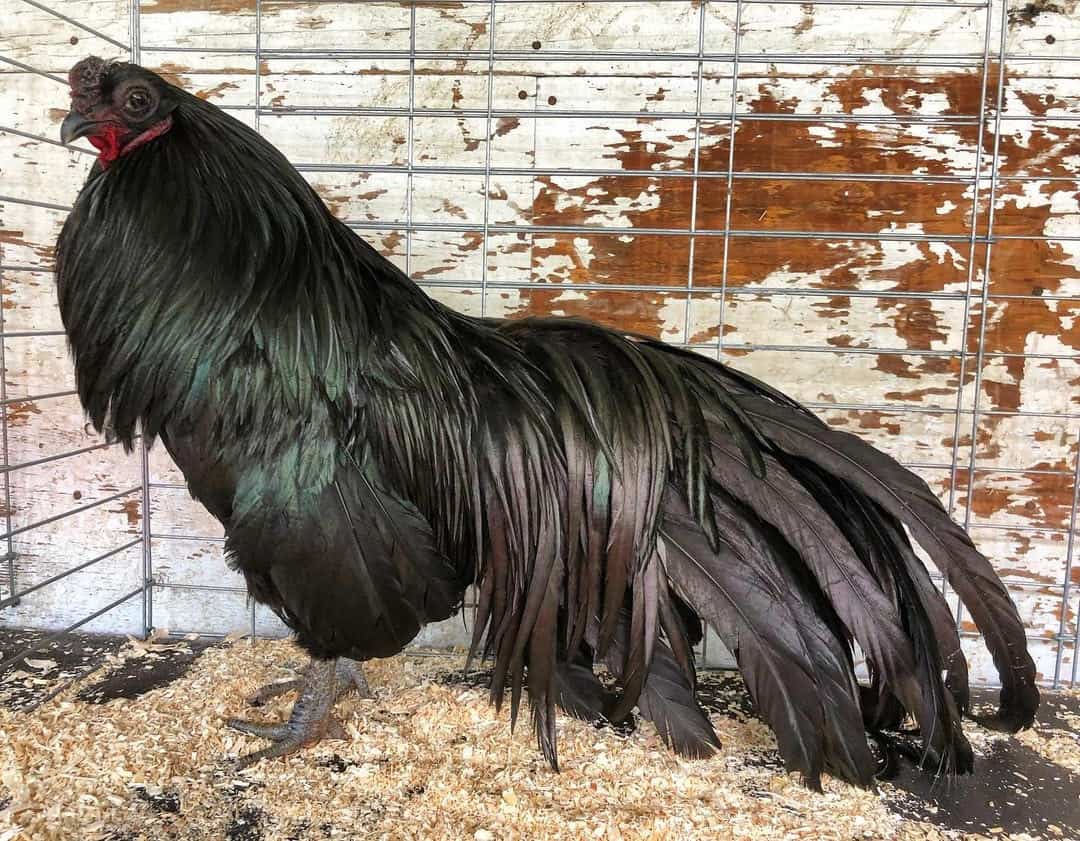
The appearance of the Sumatra chicken is beautiful. This breed has attractive plumage. The Sumatra chicken does not have a common domestic poultry appearance or behavior. This breed has a small pea comb that is a vibrant red color.
They have small wattles and small earlobes. The wattles are so small they are almost nonexistent. It is easy to distinguish a Sumatra rooster from a hen; the roosters have a distinctive greenish black shine to their feathers. The Sumatra chicken has black legs and toes. The skin of this breed is yellow.
Sumatra chickens are graceful animals. The most common color of this breed is black with a green tint, but there are other varieties. You may see the Sumatra chicken in white or blue varieties. The Blue Sumatra is rare and you will most commonly see the Black Sumatra chicken variety. The male standard weight is 2.25 – 2.70 kg and the hens average 1.8 kg.
It should be noted that the only Sumatra chicken that is recognized as the standard is the Black Sumatra chicken. There are also bantam versions of this breed available. The bantam rooster averages about 0.74 kg and the bantam hen is 0.63 kg.
Tail Characteristics:
The Sumatra chicken has a unique tail with the following traits:
- The tail is carried horizontally
- The tail has a long draping spike-like appearance
- It is long with sweeping sickles
Body Type Characteristics:
- Small frame
- Sloped, curved appearance
- Long regal-like feathers
How is the Sumatra chicken classified?
Sumatra Chicken is classified under the category of “all other breeds.” The type is listed as large fowl and bantam. Its size is classified as small, between 4-5 pounds. The rarity of Sumatra breed is rare. This breed’s purpose is identified as ornamental, and the official recognized variety is the Black Sumatra.
Why is the Sumatra breed rare?
The Sumatra chicken is listed under the “Critical” category. This is because there are fewer than 500 Sumatra birds (that can breed) available in the United States. Also, there are only 5 or fewer breeding flocks in the United States.
Personality and Temperament
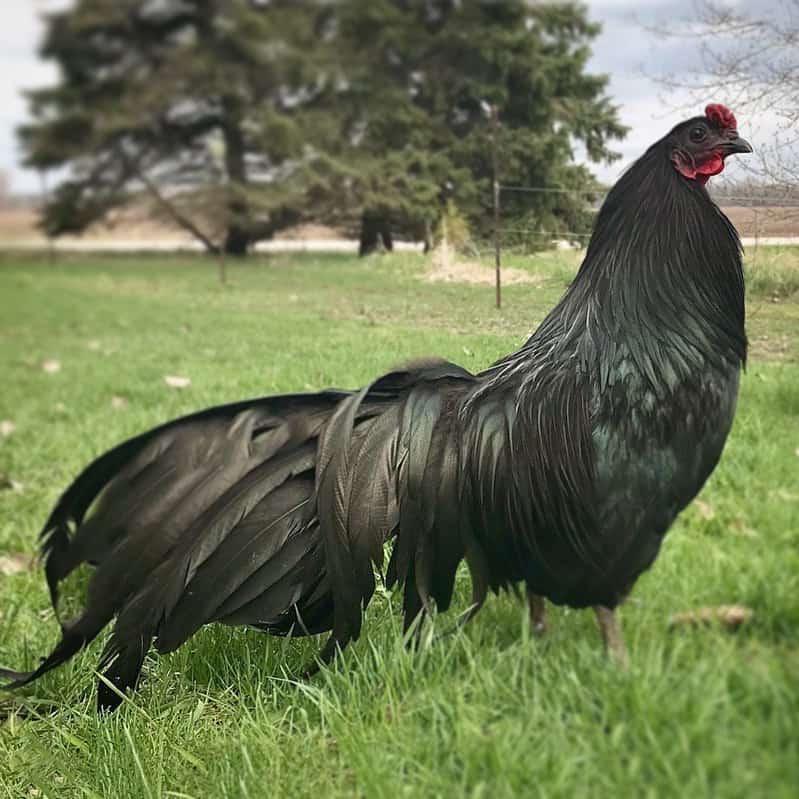
Sumatra chickens do not like to be handled. They prefer to be left alone to roam freely. Remember, the Sumatra chicken originated as a wild breed.
The Sumatra roosters can be aggressive with each other. You should pay close attention to the male Sumatra chickens during the breeding season. During this time, their behavior can gradually become more dangerous.
Historically, the Sumatra chicken was known to fly. They are great flyers, but the breed that exists today does not tend to fly. Although they don’t fly as much, they are known for their excellent launch capabilities.
They can launch vertically extremely fast to get away from danger. Due to this innate feature, they do not like to be confined. Sumatra chickens are more aggressive in confinement. Their personality thrives in open space.
The Sumatra chicken is extremely active and excellent foragers. This is one breed that has kept its original “wild” characteristics. It will take a Sumatra chicken a while to adapt to confinement.
The overall temperament of the Sumatra breed is relaxed with spurts of aggression during the breeding season. They do not like to be alone but prefer to roam and forage with other chickens.
Sumatra Chicken Egg Laying
Ornamental chicken breeds are not normally known for their egg-laying capabilities. On average the Sumatra hen lays about 100 small eggs per year. The eggs tend to be white or lightly tinted.
Hens can get broody during the breeding season and they are excellent mothers. The Sumatra hens are non-setters. Overall the Sumatra breed is a smaller breed and therefore they are not known to produce suitable meat.
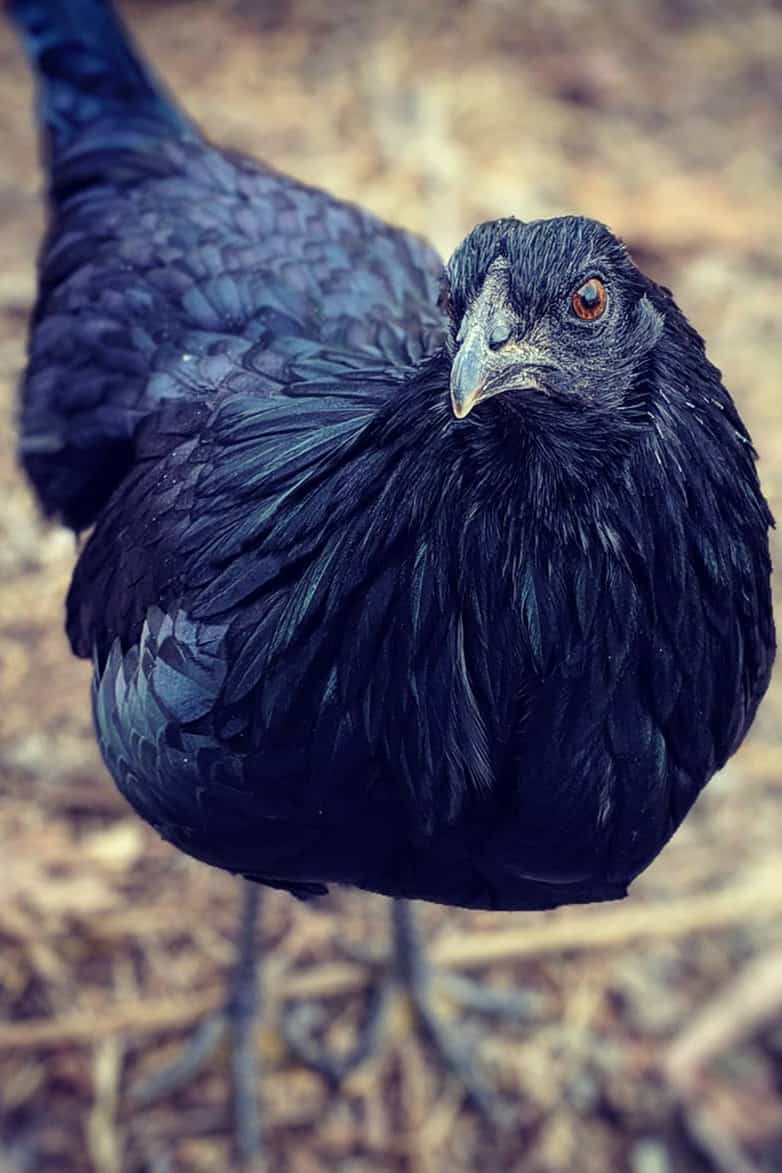
Health Issues and Care
There are not any known health issues specific to only the Sumatra chicken breed. Common health issues that can generally be seen in chickens are:
- A common health issue with chickens is the parasite lice. Poultry can be affected by parasites like lice, and they can also face issues with pests like mice. They can infect chickens and cause harm. It is best to keep areas clean and check for these parasites often.
- Another common health problem that affects chickens is worms. Worms can be dangerous because they are parasites that are able to move into the chicken’s digestive system. Worms can cause chickens discomfort. They can also take all nutrients from chickens, eventually causing them to die. It is recommended to de-worm chickens regularly.
- Another care tip is to pay close attention to chicken droppings. Droppings can tell you about the overall health of a chicken. Abnormal colors and texture of droppings can indicate a disease or health issue.
- Remove infected or sick chickens from the flock. You do not want one chicken causing fatality within the flock.
8 Tips for Raising Sumatra Chickens

- The Sumatra chicken breed does not like confinement. Consider raising them in a large open area so they can forage freely.
- Keep male Sumatra chickens separate during the breeding season. If they are left together, they will fight and eventually kill each other.
- Outside of the breeding season, it is okay to keep Sumatra chickens together. In fact, they like to be around each other and do not like to be alone.
- The Sumatra chicken still has “wild” like characteristics and they may not get along with other domesticated chickens. Pay close attention to how they interact with other breeds.
- Have high perches available for the Sumatra chicken. They often launch vertically to observe and when they feel they are in danger.
- Establish a routine with Sumatra chickens. These birds are still considered wild and it may take them a while to learn how to be in captivity. By establishing a routine, you are teaching them how to behave better in confinement.
- Consider raising chicks, as it is harder to tame an adult Sumatra chicken.
- The Sumatra chicken is hardy in the winter. This breed can withstand cold temperatures. They are also heat tolerant. Both of these characteristics are important when planning the living space for Sumatra chickens.
Summary
The Sumatra chicken breed offers a glimpse into how chickens might have appeared and behaved before domestication and cross-breeding. This breed has an impressive carriage with long flowing feathers.
Although they do not produce a great number of eggs, they are excellent ornamental birds. The Sumatra chicken is a beautiful graceful bird. More work needs to be done to make sure that this breed is seen a hundred years from now.


Joseph Hudson has been raising chickens for over 15 years. In 2018, he completed the Agriculture & Natural Resources program at Mt. San Antonio College. He currently raises over 1400 chickens on his 7.5-hectare farm. He keeps sharing his experience on raising healthy and happy chickens on Chicken Scratch The Foundry.
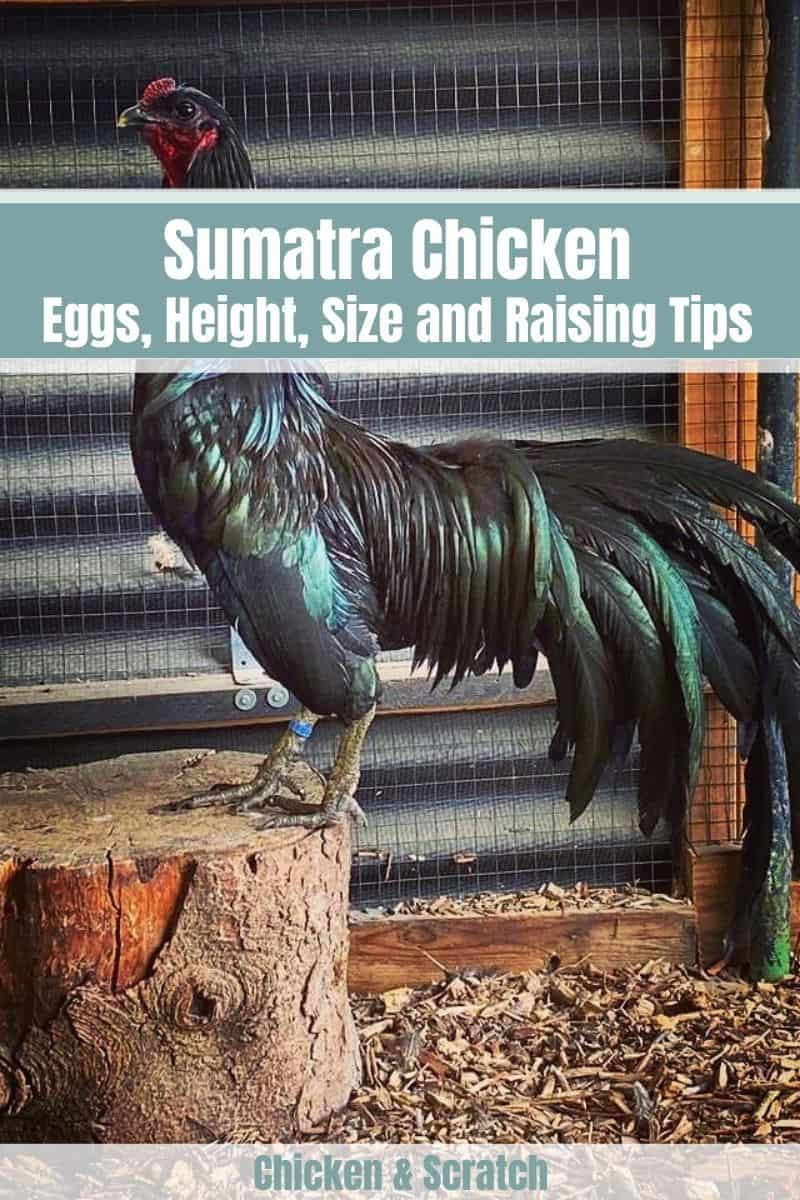







Great read ..thank you for all the information was short and to the point…GOOD JOB:)
I have a male sumantra and he is beautiful!!!